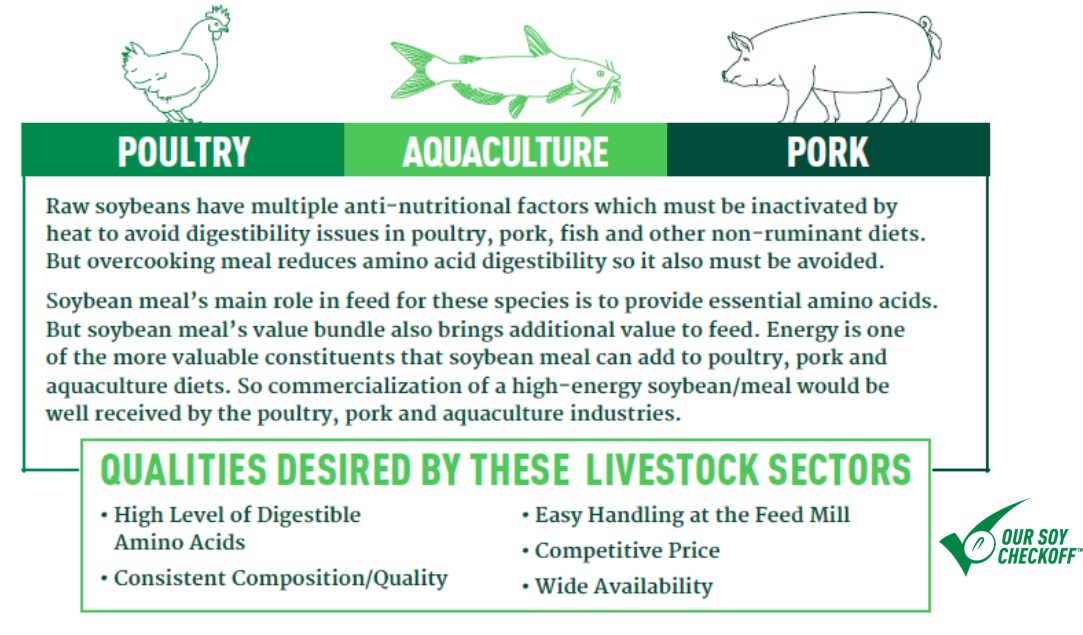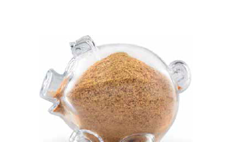From Unitedsoybean

Meeting Animal Needs Drives Meal Demand
Frankfort, Indiana, soybean farmer and USB director Mike Beard admits that for years his focus has been on soybean yield and crop marketing, believing that to be the path to profitability. Lower prices have made him question that simplistic view of crop economics.

Commanding 54 percent of the domestic meal market, the largest consumer of soybean meal is poultry.
“My soybeans ultimately feed animals all over the world,” Beard says. “While they are the best source for protein for many species, it may be possible through processing and/or composition manipulation to better meet the nutritional needs of the animals we nourish. From this standpoint, I need to know what compositional values exist in the soybeans I produce, and I need to recognize the desires of the marketplace to feed the world’s meat animals.”
Demand for soybean oil and meal are the critical factors determining market value for soybeans. Both components are important, but when it comes to providing value to farmers, meal is the engine that drives profitability.
Although the market price per pound for soybean oil is typically higher than the price per pound of meal, the comparison doesn’t mean oil contributes more value per bushel of soybeans. There is about four times more meal than oil in a bushel of soybeans.

Feeding animals all over the world with U.S. soy takes a village, and then some, to accomplish.
“Until oil delivers four times more value per pound than meal, the meal will provide more value per bushel,” says Nick Bajjalie, president of Integrative Nutrition in Decatur, Illinois. “While oil is typically higher on a per pound basis, when you look at their contributions on a per bushel of soybeans basis, meal is usually between 65 to 70 percent of the total product value.”
Bruce Weber, director of soybean product line grain marketing for CHS Inc., says comparatively, soybean oil is more stable long-term than meal. Oil can be easily stored for extended periods and pulled into the product pipeline when the market demands. Meal tends to move through the value chain more quickly.
“The need for both oil and meal makes processing plants run, depending upon what the market wants at the time,” Weber says. “Meal is more important to the price structure and the impacts of supply and demand are much closer.”
"I need to know what compostional values exist in the soybeans I produce, and I need to recognize the desires of the marketplace to feed the world's meat animals." – Mike Beard, Indiana soybean farmer
Weber says soybeans are highly valued as a meal crop. Oil uses are important to the overall product value, but buyers have more choices in the market if they’re looking for oil. Soybean meal is a different story.
“Soybean meal is still what drives profitability for processing plants and farmers,” Weber adds.
Livestock Driven
Soybean meal moves through the market as a direct reflection of livestock needs. A healthy animal agriculture sector creates demand for meal.
According to SoyStats, domestic livestock consumed more than 33.3 million tons of soybean meal in 2015. About 54 percent of the meal went to poultry, 23 percent was fed to hogs, and beef and dairy cattle consumed 12 percent and 7 percent respectively. Because of soybean meal’s availability, protein content and overall nutritional composition, it’s a preferred ingredient for most livestock feed rations.
"Soybean meal is still what drives profitability for processing plants and farmers." – Bruce Weber, CHS Inc.

“Soybean meal is an ideal protein complement to corn,” says Chris Hostetler, director of animal science for the National Pork Board. “Corn provides energy but is a relatively poor source of crude protein in general and the amino acid lysine in particular. Soybean meal, on the other hand, is relatively low in energy but high in crude protein, especially lysine. Combining corn and soybean meal provides a nutritionally balanced diet for pigs.”
“With the move to antibiotic-free programs for broilers and turkeys, the levels of soybean meal in poultry rations have increased considerably because animal proteins have largely been removed,” says Michael Lilburn, professor of animal science at The Ohio State University. “The protein and amino acids in soybean meal are highly digestible, as much as 88 to 90 percent for the essential amino acids lysine and methionine.”
For aquafeeds, soybean meal is a primary protein source, making up 20 to 45 percent of the diet depending on the fish species.
“Soybean meal is the dominant form but other products, such as lecithin soy proteins, are also used,” adds Allen Davis, professor at the Auburn University School of Fisheries, Aquaculture and Aquatic Sciences.
U.S. soybean meal’s nutritional bundle goes well beyond just crude protein to include amino acids, energy, vitamins and minerals. These components not only make up the U.S. Soy Advantage, but are also crucial to the diets for poultry and livestock.
There are plenty of feed options out there for those who work in the animal ag sector to choose from, but few options can match the complete package of U.S.
More Than Crude Protein
While today’s commodity market defines soybean meal in terms of its crude protein content, nutritionists in the U.S. and overseas are looking beyond crude protein to assess meal value.
“The primary driver in poultry and swine rations is soybean meal’s digestible amino acid profile,” Bajjalieh says. “However, other nutritional characteristics, including nutritional energy level, also contribute value. Since meal competes for usage in modern feed formulations based on its overall nutritional profile, we need to consider its ‘bundle’ of nutritional characteristics.”

More attention to meal quality from the soy industry will provide more value for our customers in animal ag.
Crude protein has long been the stick by which soybean meal quality has been measured. U.S. meal often has lower crude protein than that produced in South America, and soybeans grown in the northern United States have also traditionally been lower in protein than those grown in southern states. Measuring meal quality by more than just crude protein is changing how meal is valued.
Nutritionists formulate feed rations based on nutrient needs, but many overseas buyers still look first at price when considering meal purchases. Because it’s often higher priced than soybean meal from other origins, U.S.-produced-meal has been at a disadvantage. Shifting the value proposition to include more than crude protein could increase demand and benefit U.S. farmers.
“Filipino buyers have long been convinced that U.S. soybean meal has a higher nutrient value than any other origin,” says Basilisa Reas, U.S. Soybean Export Council animal utilization technical consultant for the Philippines. “However, price to a certain extent is still the first consideration. They will also check on the quality, but usually based on crude protein only and some physical aspects such as color and particle size.”
Reas says some feed and livestock companies have nutritionists who formulate diets based on nutrient values. They will look for the digestible essential amino acid values, especially lysine and methionine as well as threonine, tryptophan, valine and isoleucine. Those qualities may not be present in the meal they use if buyers focus on price.
A Consistent Theme
Nutritionists and buyers alike are drawn to meal that has consistent quality so they can be assured of the product they are getting and how their animals will perform. Even though soybean meal is already widely incorporated in animal diets, there is always room for improvement.
"Soybean meal is an excellent product that could be improved by increasing protein levels." – Allen Davis, Auburn University School of Fisheries, Aquaculture and Aquatic Sciences “Soybean meal is an excellent product which could be improved by increasing protein levels,” Davis says. “Some species, mostly those in the salmon family and a few marine species, have allergic-like responses to components. There are also antinutrients in the meal such as phytate and indigestible carbohydrates that could also be reduced.”
Click here to see more...